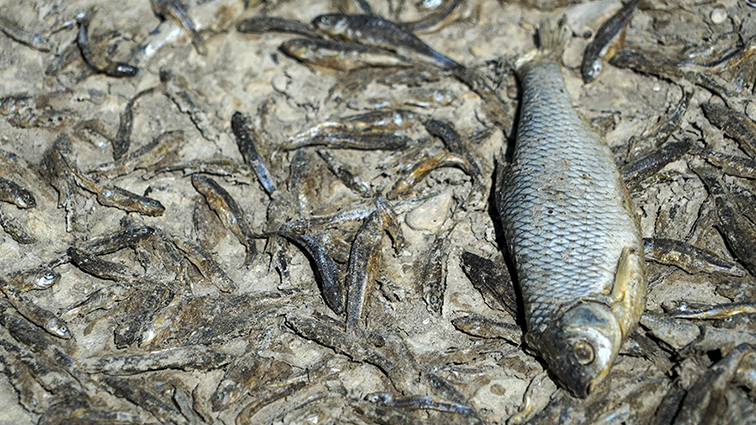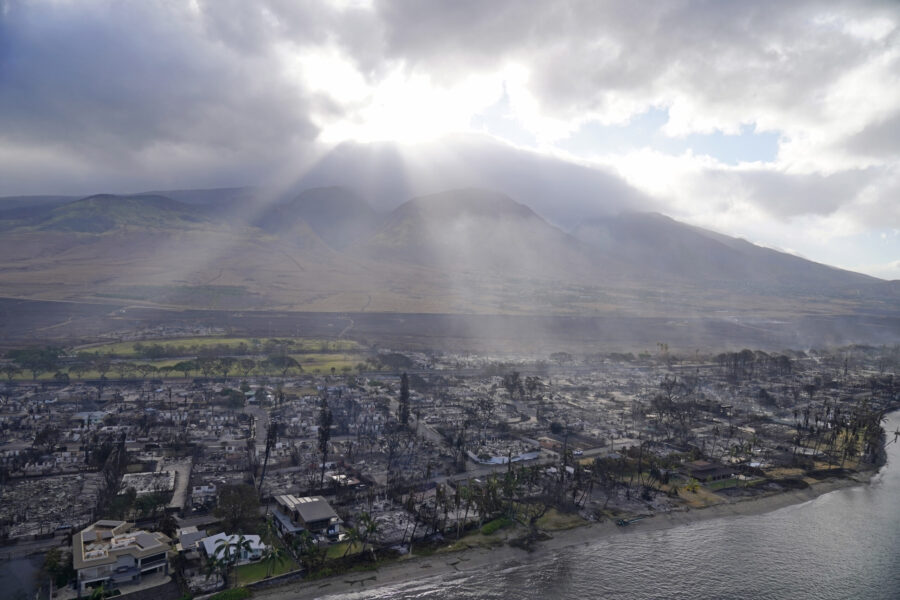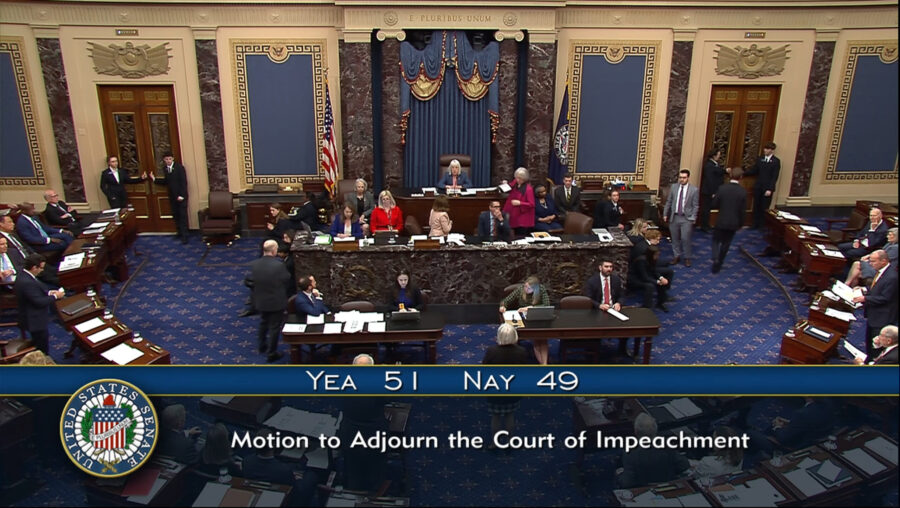Unprecedented European drought dries up rivers, kills fish, shrivels crops
Aug 23, 2022, 6:54 PM | Updated: 6:55 pm

Dead fish lay on the dried-up bed of the river Tille in Lux, France, Tuesday Aug. 9, 2022. Burgundy, home to the source of the Seine River which runs through Paris, normally is a very green region. This year, grass turned yellow, depriving livestock from fresh food, and tractors send giant clouds of dust in the air as farmers work in their dry fields. (AP Photo/Nicholas Garriga)
(AP Photo/Nicholas Garriga)
LUX, France (AP) — Once, a river ran through it. Now, white dust and thousands of dead fish cover the wide trench that winds amid rows of trees in France’s Burgundy region in what was the Tille River in the village of Lux.
From dry and cracked reservoirs in Spain to falling water levels on major arteries like the Danube, the Rhine and the Po, an unprecedented drought is afflicting nearly half of Europe. It is damaging farm economies, forcing water restrictions, causing wildfires and threatening aquatic species.
There has been no significant rainfall for almost two months in the continent’s western, central and southern regions. In typically rainy Britain, the government officially declared a drought across southern and central England on Friday amid one of the hottest and driest summers on record.
Worst drought in horn of Africa and China since records began
Worst drought USA IN 1.200 years
Worst drought Europe in 500 years
And all happening in in the third year of a record cool La Nina.
And still most people are oblivious to this new reality
Photo EPA-EFE/Shutterstock pic.twitter.com/ylikCGxyhd— GO GREEN (@ECOWARRIORSS) August 22, 2022
And Europe’s dry period is expected to continue in what experts say could be the worst drought in 500 years.
Climate change is exacerbating conditions as hotter temperatures speed up evaporation, thirsty plants take in more moisture and reduced snowfall in the winter limits supplies of fresh water available for irrigation in the summer. Europe isn’t alone in the crisis, with drought conditions also reported in East Africa, the western United States and northern Mexico.
As he walked in the 15-meter (50-foot) wide riverbed in Lux, Jean-Philippe Couasné, chief technician at the local Federation for Fishing and Protection of the Aquatic Environment, listed the species of fish that had died in the Tille.
These warships were sunk in WWII. Now, Europe's drought is causing them to resurface — and that might just lead to 'ecological disaster.' pic.twitter.com/eYQR6Tt9Pn
— NowThis (@nowthisnews) August 20, 2022
“It’s heartbreaking,” he said. “On average, about 8,000 liters (2,100 gallons) per second are flowing. … And now, zero liters.”
In areas upstream, some trout and other freshwater species can take shelter in pools via fish ladders. But such systems aren’t available everywhere.
Without rain, the river “will continue to empty. And yes, all fish will die. … They are trapped upstream and downstream, there’s no water coming in, so the oxygen level will keep decreasing as the (water) volume goes down,” Couasné said. “These are species that will gradually disappear.”
Europe in worst drought for 500 years, says report https://t.co/D7tTbC1MEB
— BBC News (UK) (@BBCNews) August 23, 2022
Jean-Pierre Sonvico, the regional head of the federation, said diverting the fish to other rivers won’t help because those waterways also are affected.
“Yes, it’s dramatic because what can we do? Nothing,” he said. “We’re waiting, hoping for storms with rain, but storms are very local so we can’t count on it.”
The European Commission’s Joint Research Center warned this week that drought conditions will get worse and potentially affect 47% of the continent. Andrea Toreti, a senior researcher at the European Drought Observatory, said a drought in 2018 was so extreme that there were no similar events for the last 500 years, “but this year, I think, it is really worse.”
For the next three months, “we see still a very high risk of dry conditions over Western and Central Europe, as well as the U.K.,” Toreti said.
Current conditions result from long periods of dry weather caused by changes in world weather systems, said meteorologist Peter Hoffmann of the Potsdam Institute for Climate Impact Research near Berlin.
Europe and the US not the only Drought stricken regions. The Yangtze River in China has shrunken to half its normal width. They’ve had to close canals supplied by this water. pic.twitter.com/fOE66uGMik
— Peter Dynes (@PGDynes) August 19, 2022
“It’s just that in summer we feel it the most,” he said. “But actually the drought builds up across the year.”
Climate change has lessened temperature differences between regions, sapping the forces that drive the jet stream, which normally brings wet Atlantic weather to Europe, he said.
A weaker or unstable jet stream can bring unusually hot air to Europe from North Africa, leading to prolonged periods of heat. The reverse is also true, when a polar vortex of cold air from the Arctic can cause freezing conditions far south of where it would normally reach.
Hoffmann said observations in recent years have all been at the upper end of what existing climate models predicted.
The drought in Europe…
47% of the EU territory is in ‘Warning’ conditions and 17% is in ‘Alert’ conditions.
This has serious impact on food production & river transport. Horrific timing when already a food crisis and high energy costs with Russian invasion of Ukraine. pic.twitter.com/Pq02P4mT9s
— Scott Duncan (@ScottDuncanWX) August 20, 2022
The drought has caused some European countries to restrict water usage, and shipping is endangered on the Rhine and the Danube rivers.
The Rhine, Germany’s biggest waterway, is forecast to reach critically low levels in the coming days. Authorities say it could become difficult for many large ships to safely navigate the river at the city of Kaub, roughly midway between Koblenz and Mainz.
On the Danube, authorities in Serbia have started dredging to keep vessels moving.
In neighboring Hungary, wide parts of Lake Velence near Budapest have turned into patches of dried mud, beaching small boats. Aeration and water circulation equipment was installed to protect wildlife, but water quality has deteriorated. A weekend swimming ban was imposed at one beach.
Stretches of the Po, Italy’s longest river, are so low that barges and boats that sank decades ago are resurfacing.
Italy’s Lake Garda has fallen to its lowest levels ever, and people who flocked to the popular spot east of Milan at the start of a long summer weekend found a newly exposed shoreline of bleached rocks with a yellow hue. Authorities recently released more water from the lake, Italy’s largest, to help with irrigation, but halted the effort to protect the lucrative tourist season.
A single map for the worst #drought in 500 years in Europe. The river discharge anomaly based on reanalysis data from June to August 12 2022, shows an average negative anomaly of -29%, even reaching less than -62% at some points. #rstats #dataviz pic.twitter.com/LSGMfS52Lm
— Dr. Dominic Royé (@dr_xeo) August 14, 2022
The drought also has affected England, which last month had its driest July since 1935, according to the Met Office weather agency. The lack of rain has depleted reservoirs, rivers and groundwater and left grasslands brown and tinder-dry.
Millions in the U.K. already were barred from watering lawns and gardens, and 15 million more around London will face such a ban soon.
U.K. farmers face running out of irrigation water and having to use winter feed for animals because of a lack of grass. The Rivers Trust charity said England’s chalk streams — which allow underground springs to bubble up through the spongy layer of rock — are drying up, endangering aquatic wildlife like kingfishers and trout.
Even countries like Spain and Portugal, which are used to long periods without rain, have seen major consequences. In the Spanish region of Andalucia, some avocado farmers have had to sacrifice hundreds of trees to save others from wilting as the Vinuela reservoir in Malaga province dropped to only 13% of capacity.
Europe and the US not the only Drought stricken regions. Lake Chad in Central Africa has shrunken by as much as 95% of its normal size. It has fuelled massive environmental and humanitarian crisis. Over 10 million people across the region are in need of emergency assistance. pic.twitter.com/WOMXvmh2nh
— MulindwaMoses (@mulindwa_guy) August 22, 2022
Some European farmers are using water from the tap for their livestock when ponds and streams go dry, using up to 100 liters (26 gallons) a day per cow.
In normally green Burgundy, the source of Paris’ Seine River, the grass has turned yellow-brown and tractors churn up giant clouds of dust.
Baptiste Colson, who owns dairy cows and grows feed crops in the village of Moloy, said his animals are suffering, with the quality and quantity of their milk decreasing. The 31-year-old head of the local Young Farmers union said he has been forced to dip into his winter fodder in August.
“That is the biggest concern,” Colson said.
EU corn production is expected to be 12.5 million tons below last year and sunflower production is projected to be 1.6 million tons lower, according to S&P Global Commodity Insights.
Colson expects at least a 30% drop in corn yields, a major problem for feeding his cows.
“We know we’ll have to buy food … so the cows can continue producing milk,” he said. “From an economic point of view, the cost will be high.”
In Europe the drought is so deep that Nazi gunships have resurfaced along the Danube, still loaded with the ammunition that was onboard when the Germans sunk them to prevent their capture by the advancing Russians. https://t.co/D4N5YeY4Y6
— Bill McKibben (@billmckibben) August 23, 2022
The Danube River is running so low on water that the wreckage of German battleships, sunk in 1944, has resurfaced, posing a danger to local ship traffic. https://t.co/qfOZAMxDMX
— The New York Times (@nytimes) August 23, 2022
Dana Beltaji and Jill Lawless in London, Frank Jordans in Berlin, Barry Hatton in Lisbon, Portugal, Ciarán Giles in Madrid, Dusan Stojanovic in Belgrade, Serbia, and Bela Szandelszky in Budapest, Hungary, and Andrea Rosa and Luigi Navarra in Sirmione, Italy, contributed.
Follow AP’s climate coverage at https://apnews.com/hub/climate-and-environment













